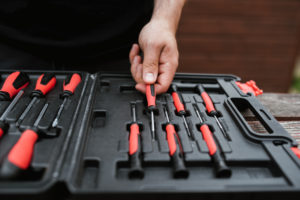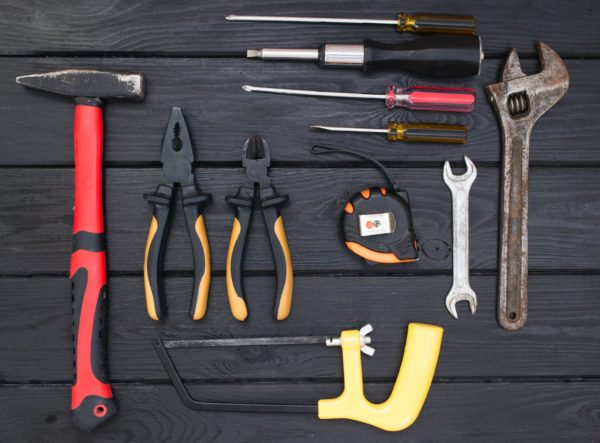If you’re wondering how to organize tools in a tool chest, then you’ve come to the right place. Most homeowners and avid DIYers have a number of Hand Tools and or Woodcutting Tools and even Carpenter Tools that need to be housed somewhere conveniently and with efficiency of storage. An organized tool chest is awesome as there’s nothing worse than losing an essential item in a disorganized toolbox of chaos.

Organizing your tool chest is also a foolproof way of improving productivity as no time will be wasted looking for the right tool or size needed for a job. But, how do you achieve this when there are a number of tools that need to be stored in a tool chest?
Well, we save you the trouble of figuring this out by covering all the must-knows in this guide.
How to Organize Tools in a Tool Chest – Step by Step Instructions
Tool organization is not a complicated process rather one that requires a little dedication and attention to the needs at hand. As a beginner, the first step should be to find the right tool chest. The best way to do this is by focusing on:
- The storage capacity of the tool chest. While this might sound obvious, many homeowners and DIYers have found themselves buying smaller tool chests than they need. Therefore, it is vital to know how many tools you currently have and are likely to purchase in the future. This should then be used as the guide when looking for a tool chest.
- The number of drawers on the tool chest. As you strive to have ample storage space for your tools, it is crucial to consider the numbers of drawers on a tool chest. Tool organization becomes simpler when there are several drawers as you can easily separate various types of tools by placing them in different drawers. For example, you can opt to have hand tools placed on the top drawer, woodcutting tools on the second drawer, and carpenter tools in the third drawer.
- The material that has been used to manufacture the tool chest. It is important to consider the type of material a tool chest is made of since this determines its durability. The last thing you need is a tool chest that will quickly get worn out or get damaged after a short period of use.
Once you have the right tool chest, it is now time to gather all your tools and find the best way to organize them. While there are no hard rules to how you must do this, the general guideline to be followed involves:
Preparing an inventory of tools before sorting

Before you rush into organizing your tool chest, the first step should be to prepare an inventory of all your tools. This is an essential task that will give you a detailed overview of how many tools you currently have. It will also be an eye-opening process that will help you determine whether you have missing or broken tools.
Preparing an inventory will also make it possible to categorize the tools you have with great ease. Your categorization style can be based on the tools’ weight & size, frequency of use, or function. A rule to adhere to when categorizing your tools is to sort them in as much detail as possible.
- Sorting out your tools
After preparing an inventory of your tools and categorizing them on paper, it is time to sort them out. It is advisable to start with the smallest tools and work up to the biggest ones. This is a foolproof approach that will see you create organized groups of tools.
As you sort out the tools, ensure you place them in the right sub-categories to avoid confusion later. For example – if you are sorting out screwdrivers, ensure the flatheads and Philip’s heads are placed separately. The same should apply to all tools that come in different types and sizes.
-
Deciding the best way of placing the tools depending on how they have been sorted

Once you are done sorting out your tools, the next step is deciding how best they will be placed in the tool chest. This is a decision that should be based on the construction style of your tool chest. If it has larger drawers on the top, then it is only practical to place larger tools on these drawers.
On the other hand, if the tool chest has drawers of similar sizes and shapes, you can decide to place your tools depending on how frequently they are used. This is one of the best strategies, as it will be convenient for you to find what you need instantly. You could then opt to have duplicate tools and those not frequently used in the bottom drawers.
-
Make use of tool organizing solutions
Finally, before you start implementing your plan, finding the right tool organization solutions is essential. The practicality of opting for these solutions is that they make it easier for you to efficiently use the available drawer space. This is because they offer you the flexibility of customizing your drawers for the safe storage of all tools.
Among the tool organizing solutions for you to consider are:
- Small parts organizers. The challenge of efficiently storing small parts is quickly resolved by using small parts organizers. These can hold parts like nuts & bolts, sockets, crowfoot wrenches, and washers.
- Drawer liners and dividers. Drawer liners are a must-have if you want to protect your drawers from scratches and damages that might be caused by tools. They also prevent tools from rolling by securely holding them in place. You will also benefit from using drawer dividers, which help keep a drawer neat as they come handy in creating compartments.
- Individual tool organizers. If you are after a simple way of organizing tools like sockets, wrenches, and pliers that come in a range of sizes and styles, then individual tool organizers are the go-for solution.
- Customized foam organizers. If you are looking to organize tools in a tool chest neatly, then you will love the efficiency of using customized foam organizers. These foam cut-outs are designed to accommodate different types of tools by providing tight-fit spaces for each tool. They will also make it easier for you to identify missing tools immediately when you open a drawer.
Bottom-line For Tool Organization
As an avid DIY or homeowner, you require several tools for repairs and different projects. Whether you have invested in hand tools, woodcutting tools, or carpenter tools, you need to know how to organize tools in a tool chest. This guide provides a pathway that will save you from the frustrations of continually spending a lot of time looking for a tool instead of performing the actual job.
Interested in other articles?
